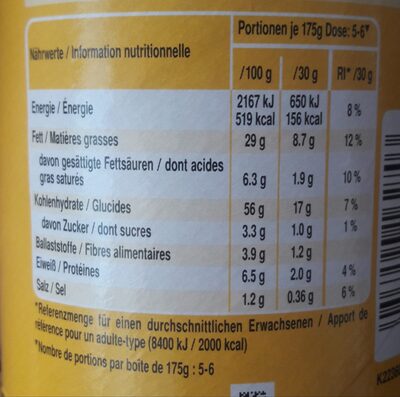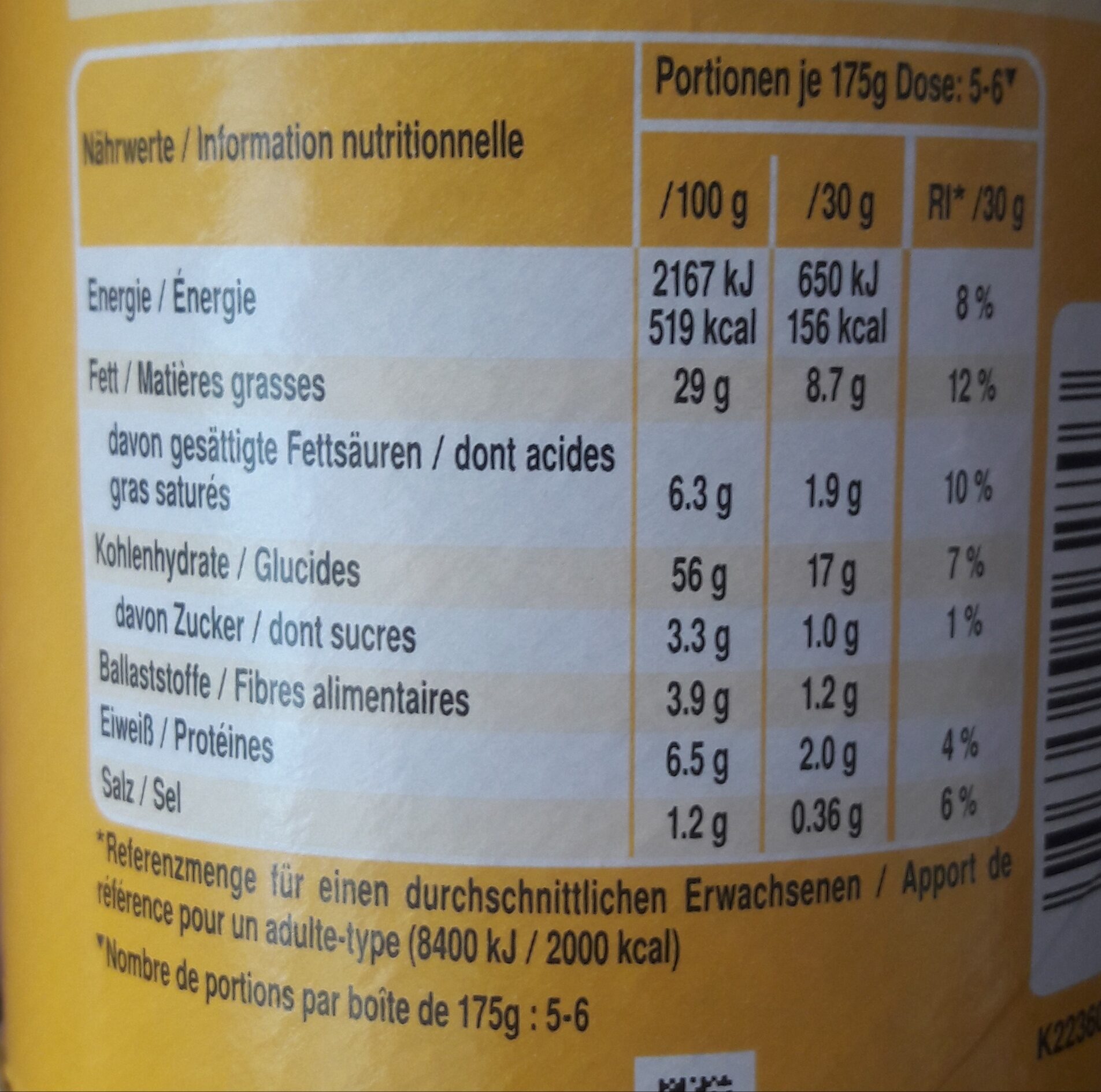Help us make food transparency the norm!
As a non-profit organization, we depend on your donations to continue informing consumers around the world about what they eat.
The food revolution starts with you!
Paprika - Pringles - 175 g
Paprika - Pringles - 175 g
This product page is not complete. You can help to complete it by editing it and adding more data from the photos we have, or by taking more photos using the app for Android or iPhone/iPad. Thank you!
×
Barcode: 5053990162703 (EAN / EAN-13)
Common name: Snack salé au goût paprika
Quantity: 175 g
Packaging: Plastic, Metal, Cardboard, Recyclable Metals, Aluminium, Tube
Brands: Pringles
Categories: Snacks, Salty snacks, Appetizers, Chips and fries, Crisps, Salty snacks made from potato
Labels, certifications, awards:
Vegetarian, Triman
Manufacturing or processing places: Belgique
Traceability code: K214648000
Link to the product page on the official site of the producer: https://www.pringles.com/fr/products/cla...
Stores: carrefour.fr, Carrefour
Countries where sold: France
Matching with your preferences
Health
Ingredients
-
36 ingredients
French: Pommes de terre déshydratées, huiles végétales (huile de tournesol, huile de palme, huile de maïs), farine de blé, farine de maïs, farine de riz, paprika (chapelure (blé), dextrose, levure en poudre, sucre, paprika en poudre, exhausteurs de goût (glutamate monosodique, guanylate disodique, inosinate disodique), oignon en poudre, sel, arômes, maltodextrine, lactosérum en poudre (lait), ail en poudre, arômes de fumée, colorant (extrait de paprika), acidifiant (acide citrique)), maltodextrine, émulsifiant (E471), sel, colorant (norbixine).Allergens: Gluten, MilkTraces: Soybeans
Food processing
-
Ultra processed foods
Elements that indicate the product is in the 4 - Ultra processed food and drink products group:
- Additive: E160b - Annatto
- Additive: E160c - Paprika extract
- Additive: E471 - Mono- and diglycerides of fatty acids
- Additive: E621 - Monosodium glutamate
- Additive: E627 - Disodium guanylate
- Additive: E631 - Disodium inosinate
- Ingredient: Colour
- Ingredient: Dextrose
- Ingredient: Emulsifier
- Ingredient: Flavour enhancer
- Ingredient: Flavouring
- Ingredient: Glucose
- Ingredient: Maltodextrin
- Ingredient: Whey
Food products are classified into 4 groups according to their degree of processing:
- Unprocessed or minimally processed foods
- Processed culinary ingredients
- Processed foods
- Ultra processed foods
The determination of the group is based on the category of the product and on the ingredients it contains.
Additives
-
E330 - Citric acid
Citric acid is a natural organic acid found in citrus fruits such as lemons, oranges, and limes.
It is widely used in the food industry as a flavor enhancer, acidulant, and preservative due to its tart and refreshing taste.
Citric acid is safe for consumption when used in moderation and is considered a generally recognized as safe (GRAS) food additive by regulatory agencies worldwide.
-
E471 - Mono- and diglycerides of fatty acids
Mono- and diglycerides of fatty acids (E471), are food additives commonly used as emulsifiers in various processed foods.
These compounds consist of glycerol molecules linked to one or two fatty acid chains, which help stabilize and blend water and oil-based ingredients. E471 enhances the texture and shelf life of products like margarine, baked goods, and ice cream, ensuring a smooth and consistent texture.
It is generally considered safe for consumption within established regulatory limits.
-
E621 - Monosodium glutamate
Monosodium glutamate: Monosodium glutamate -MSG, also known as sodium glutamate- is the sodium salt of glutamic acid, one of the most abundant naturally occurring non-essential amino acids. Glutamic acid is found naturally in tomatoes, grapes, cheese, mushrooms and other foods.MSG is used in the food industry as a flavor enhancer with an umami taste that intensifies the meaty, savory flavor of food, as naturally occurring glutamate does in foods such as stews and meat soups. It was first prepared in 1908 by Japanese biochemist Kikunae Ikeda, who was trying to isolate and duplicate the savory taste of kombu, an edible seaweed used as a base for many Japanese soups. MSG as a flavor enhancer balances, blends, and rounds the perception of other tastes.The U.S. Food and Drug Administration has given MSG its generally recognized as safe -GRAS- designation. A popular belief is that large doses of MSG can cause headaches and other feelings of discomfort, known as "Chinese restaurant syndrome," but double-blind tests fail to find evidence of such a reaction. The European Union classifies it as a food additive permitted in certain foods and subject to quantitative limits. MSG has the HS code 29224220 and the E number E621.Source: Wikipedia
-
E627 - Disodium guanylate
Disodium guanylate: Disodium guanylate, also known as sodium 5'-guanylate and disodium 5'-guanylate, is a natural sodium salt of the flavor enhancing nucleotide guanosine monophosphate -GMP-. Disodium guanylate is a food additive with the E number E627. It is commonly used in conjunction with glutamic acid. As it is a fairly expensive additive, it is not used independently of glutamic acid; if disodium guanylate is present in a list of ingredients but MSG does not appear to be, it is likely that glutamic acid is provided as part of another ingredient such as a processed soy protein complex. It is often added to foods in conjunction with disodium inosinate; the combination is known as disodium 5'-ribonucleotides. Disodium guanylate is produced from dried seaweed and is often added to instant noodles, potato chips and other snacks, savory rice, tinned vegetables, cured meats, and packaged soup.Source: Wikipedia
-
E631 - Disodium inosinate
Disodium inosinate: Disodium inosinate -E631- is the disodium salt of inosinic acid with the chemical formula C10H11N4Na2O8P. It is used as a food additive and often found in instant noodles, potato chips, and a variety of other snacks. Although it can be obtained from bacterial fermentation of sugars, it is often commercially prepared from animal sources.Source: Wikipedia
Ingredients analysis
-
Palm oil
Ingredients that contain palm oil: Palm oil
-
Non-vegan
Non-vegan ingredients: Whey powder
-
Vegetarian
No non-vegetarian ingredients detected
-
Details of the analysis of the ingredients
fr: Pommes de terre, huiles végétales (huile de tournesol, huile de palme, huile de maïs), farine de _blé_, farine de maïs, farine de riz, paprika (chapelure (_blé_), dextrose, levure en poudre, sucre, paprika en poudre, exhausteurs de goût (glutamate monosodique, guanylate disodique, inosinate disodique), oignon, sel, arômes, maltodextrine, lactosérum en poudre, ail, arômes de fumée, colorant (extrait de paprika), acidifiant (acide citrique)), maltodextrine, émulsifiant (e471), sel, colorant (norbixine)- Pommes de terre -> en:potato - vegan: yes - vegetarian: yes - ciqual_food_code: 4003 - percent_min: 10 - percent_max: 100
- huiles végétales -> en:vegetable-oil - vegan: yes - vegetarian: yes - from_palm_oil: maybe - percent_min: 0 - percent_max: 50
- huile de tournesol -> en:sunflower-oil - vegan: yes - vegetarian: yes - from_palm_oil: no - ciqual_food_code: 17440 - percent_min: 0 - percent_max: 50
- huile de palme -> en:palm-oil - vegan: yes - vegetarian: yes - from_palm_oil: yes - ciqual_food_code: 16129 - percent_min: 0 - percent_max: 25
- huile de maïs -> en:corn-oil - vegan: yes - vegetarian: yes - from_palm_oil: no - ciqual_food_code: 17190 - percent_min: 0 - percent_max: 16.6666666666667
- farine de _blé_ -> en:wheat-flour - vegan: yes - vegetarian: yes - ciqual_proxy_food_code: 9410 - percent_min: 0 - percent_max: 33.3333333333333
- farine de maïs -> en:corn-flour - vegan: yes - vegetarian: yes - ciqual_food_code: 9545 - percent_min: 0 - percent_max: 25
- farine de riz -> en:rice-flour - vegan: yes - vegetarian: yes - ciqual_food_code: 9520 - percent_min: 0 - percent_max: 20
- paprika -> en:paprika - vegan: yes - vegetarian: yes - ciqual_food_code: 11049 - percent_min: 0 - percent_max: 16.6666666666667
- chapelure -> en:breadcrumbs - vegan: maybe - vegetarian: maybe - ciqual_food_code: 7500 - percent_min: 0 - percent_max: 16.6666666666667
- _blé_ -> en:wheat - vegan: yes - vegetarian: yes - ciqual_proxy_food_code: 9410 - percent_min: 0 - percent_max: 16.6666666666667
- dextrose -> en:dextrose - vegan: yes - vegetarian: yes - ciqual_proxy_food_code: 31016 - percent_min: 0 - percent_max: 8.33333333333333
- levure en poudre -> en:yeast-powder - vegan: yes - vegetarian: yes - percent_min: 0 - percent_max: 5.55555555555556
- sucre -> en:sugar - vegan: yes - vegetarian: yes - ciqual_proxy_food_code: 31016 - percent_min: 0 - percent_max: 3.3
- paprika en poudre -> en:paprika-powder - vegan: yes - vegetarian: yes - ciqual_food_code: 11049 - percent_min: 0 - percent_max: 3.3
- exhausteurs de goût -> en:flavour-enhancer - percent_min: 0 - percent_max: 2.77777777777778
- glutamate monosodique -> en:e621 - vegan: yes - vegetarian: yes - percent_min: 0 - percent_max: 2.77777777777778
- guanylate disodique -> en:e627 - vegan: maybe - vegetarian: maybe - percent_min: 0 - percent_max: 1.38888888888889
- inosinate disodique -> en:e631 - vegan: maybe - vegetarian: maybe - percent_min: 0 - percent_max: 0.925925925925926
- oignon -> en:onion - vegan: yes - vegetarian: yes - ciqual_food_code: 20034 - percent_min: 0 - percent_max: 2.38095238095238
- sel -> en:salt - vegan: yes - vegetarian: yes - ciqual_food_code: 11058 - percent_min: 0 - percent_max: 1.2
- arômes -> en:flavouring - vegan: maybe - vegetarian: maybe - percent_min: 0 - percent_max: 1.2
- maltodextrine -> en:maltodextrin - vegan: yes - vegetarian: yes - percent_min: 0 - percent_max: 1.2
- lactosérum en poudre -> en:whey-powder - vegan: no - vegetarian: maybe - percent_min: 0 - percent_max: 1.2
- ail -> en:garlic - vegan: yes - vegetarian: yes - ciqual_food_code: 11000 - percent_min: 0 - percent_max: 1.2
- arômes de fumée -> en:smoke-flavouring - vegan: maybe - vegetarian: maybe - percent_min: 0 - percent_max: 1.2
- colorant -> en:colour - percent_min: 0 - percent_max: 1.2
- extrait de paprika -> en:e160c - vegan: yes - vegetarian: yes - percent_min: 0 - percent_max: 1.2
- acidifiant -> en:acid - percent_min: 0 - percent_max: 1.2
- acide citrique -> en:e330 - vegan: yes - vegetarian: yes - percent_min: 0 - percent_max: 1.2
- chapelure -> en:breadcrumbs - vegan: maybe - vegetarian: maybe - ciqual_food_code: 7500 - percent_min: 0 - percent_max: 16.6666666666667
- maltodextrine -> en:maltodextrin - vegan: yes - vegetarian: yes - percent_min: 0 - percent_max: 14.2857142857143
- émulsifiant -> en:emulsifier - percent_min: 0 - percent_max: 12.5
- e471 -> en:e471 - vegan: maybe - vegetarian: maybe - from_palm_oil: maybe - percent_min: 0 - percent_max: 12.5
- sel -> en:salt - vegan: yes - vegetarian: yes - ciqual_food_code: 11058 - percent_min: 0 - percent_max: 1.2
- colorant -> en:colour - percent_min: 0 - percent_max: 1.2
- norbixine -> en:e160b - vegan: yes - vegetarian: yes - percent_min: 0 - percent_max: 1.2
Nutrition
-
Poor nutritional quality
This product is not considered a beverage for the calculation of the Nutri-Score.
Positive points: 4
- Proteins: 4 / 5 (value: 6.5, rounded value: 6.5)
- Fiber: 4 / 5 (value: 3.9, rounded value: 3.9)
- Fruits, vegetables, nuts, and colza/walnut/olive oils: 0 / 5 (value: 0, rounded value: 0)
Negative points: 17
- Energy: 6 / 10 (value: 2167, rounded value: 2167)
- Sugars: 0 / 10 (value: 3.3, rounded value: 3.3)
- Saturated fat: 6 / 10 (value: 6.3, rounded value: 6.3)
- Sodium: 5 / 10 (value: 480, rounded value: 480)
The points for proteins are not counted because the negative points are greater or equal to 11.
Nutritional score: (17 - 4)
Nutri-Score:
-
Nutrient levels
-
Fat in high quantity (29%)
What you need to know- A high consumption of fat, especially saturated fats, can raise cholesterol, which increases the risk of heart diseases.
Recommendation: Limit the consumption of fat and saturated fat- Choose products with lower fat and saturated fat content.
-
Saturated fat in high quantity (6.3%)
What you need to know- A high consumption of fat, especially saturated fats, can raise cholesterol, which increases the risk of heart diseases.
Recommendation: Limit the consumption of fat and saturated fat- Choose products with lower fat and saturated fat content.
-
Sugars in low quantity (3.3%)
What you need to know- A high consumption of sugar can cause weight gain and tooth decay. It also augments the risk of type 2 diabetes and cardio-vascular diseases.
Recommendation: Limit the consumption of sugar and sugary drinks- Sugary drinks (such as sodas, fruit beverages, and fruit juices and nectars) should be limited as much as possible (no more than 1 glass a day).
- Choose products with lower sugar content and reduce the consumption of products with added sugars.
-
Salt in moderate quantity (1.2%)
What you need to know- A high consumption of salt (or sodium) can cause raised blood pressure, which can increase the risk of heart disease and stroke.
- Many people who have high blood pressure do not know it, as there are often no symptoms.
- Most people consume too much salt (on average 9 to 12 grams per day), around twice the recommended maximum level of intake.
Recommendation: Limit the consumption of salt and salted food- Reduce the quantity of salt used when cooking, and don't salt again at the table.
- Limit the consumption of salty snacks and choose products with lower salt content.
-
-
Nutrition facts
Nutrition facts As sold
for 100 g / 100 mlAs sold
per serving (30 g)Compared to: Salty snacks made from potato Energy 2,167 kj
(519 kcal)650 kj
(156 kcal)+1% Fat 29 g 8.7 g -3% Saturated fat 6.3 g 1.89 g +51% Carbohydrates 56 g 16.8 g - Sugars 3.3 g 0.99 g +7% Fiber 3.9 g 1.17 g +18% Proteins 6.5 g 1.95 g +42% Salt 1.2 g 0.36 g -19% Fruits‚ vegetables‚ nuts and rapeseed‚ walnut and olive oils (estimate from ingredients list analysis) 0 % 0 %
Environment
-
Eco-Score C - Moderate environmental impact
⚠ ️Select a country in order to include the full impact of transportation.The Eco-Score is an experimental score that summarizes the environmental impacts of food products.→ The Eco-Score was initially developped for France and it is being extended to other European countries. The Eco-Score formula is subject to change as it is regularly improved to make it more precise and better suited to each country.Life cycle analysis
-
Average impact of products of the same category: A (Score: 87/100)
Category: Salty snacks, made from potato
Category: Salty snacks, made from potato
- PEF environmental score: 0.22 (the lower the score, the lower the impact)
- including impact on climate change: 1.59 kg CO2 eq/kg of product
Stage Impact Agriculture
59.7 %Processing
22.4 %Packaging
10.6 %Transportation
5.2 %Distribution
2.2 %Consumption
0.0 %
Bonuses and maluses
-
Missing origins of ingredients information
Malus: -5
⚠ ️ The origins of the ingredients of this product are not indicated.
If they are indicated on the packaging, you can modify the product sheet and add them.
If you are the manufacturer of this product, you can send us the information with our free platform for producers.
-
Ingredients that threatens species
Malus: -10
Contains palm oil
Tropical forests in Asia, Africa and Latin America are destroyed to create and expand oil palm tree plantations. The deforestation contributes to climate change, and it endangers species such as the orangutan, the pigmy elephant and the Sumatran rhino.
-
Packaging with a medium impact
Malus: -13
Shape Material Recycling Impact 1 Tube Armed cardboard Recycle Low 1 Seal Heavy aluminium Recycle Medium 1 Lid PP 5 - Polypropylene Recycle High Card Unknown High ⚠ ️ The information about the packaging of this product is not sufficiently precise (exact shapes and materials of all components of the packaging).⚠ ️ For a more precise calculation of the Eco-Score, you can modify the product page and add them.
If you are the manufacturer of this product, you can send us the information with our free platform for producers.
Eco-Score for this product
-
Impact for this product: C (Score: 59/100)
Product: Paprika - Pringles - 175 g
Life cycle analysis score: 87
Sum of bonuses and maluses: -28
Final score: 59/100
-
Carbon footprint
-
Equal to driving 0.8 km in a petrol car
159 g CO² per 100g of product
The carbon emission figure comes from ADEME's Agribalyse database, for the category: Salty snacks, made from potato (Source: ADEME Agribalyse Database)
Stage Impact Agriculture
53.6 %Processing
18.8 %Packaging
17.7 %Transportation
8.7 %Distribution
1.2 %Consumption
0.0 %
Packaging
-
Packaging with a medium impact
-
Packaging parts
1 x Tube 175 g (Armed cardboard: 42.78 g)
1 x Seal (Aluminium: 0.66 g)
1 x Lid (PP 5 - Polypropylene: 3.06 g)
Card
-
Packaging materials
Material % Packaging weight Packaging weight per 100 g of product Paper or cardboard 92% 42.78 g 24.4 g Plastic 6.6% 3.06 g 1.7 g Metal 1.4% 0.66 g 0.4 g Total 100% 46.5 g 26.6 g
-
Transportation
-
Origins of ingredients
Missing origins of ingredients information
⚠ ️ The origins of the ingredients of this product are not indicated.
If they are indicated on the packaging, you can modify the product sheet and add them.
If you are the manufacturer of this product, you can send us the information with our free platform for producers.Add the origins of ingredients for this product Add the origins of ingredients for this product
Threatened species
-
Contains palm oil
Drives deforestation and threatens species such as the orangutan
Tropical forests in Asia, Africa and Latin America are destroyed to create and expand oil palm tree plantations. The deforestation contributes to climate change, and it endangers species such as the orangutan, the pigmy elephant and the Sumatran rhino.
Report a problem
-
Incomplete or incorrect information?
Category, labels, ingredients, allergens, nutritional information, photos etc.
If the information does not match the information on the packaging, please complete or correct it. Open Food Facts is a collaborative database, and every contribution is useful for all.
Data sources
Product added on by kiliweb
Last edit of product page on by grobschlacht.
Product page also edited by aleene, danis1597, driveoff, halal-app-chakib, narine, off.7763d75e-4bda-4a5f-ab4f-5806d0112ad6, openfoodfacts-contributors, pommeorange147, quechoisir, roboto-app, yuka.sY2b0xO6T85zoF3NwEKvlkYac4CPjgjgCzHfqRSHwvirIrHVW8BCs9PjMas, yuka.sY2b0xO6T85zoF3NwEKvlkx5SviHgyz_bxrvhBa1nceRA6O1YI5R_LfeA6s, yuka.sY2b0xO6T85zoF3NwEKvllF2XfXe_S_BZznkqGe2nveAJbbvPdMt2NPKNqg, yuka.sY2b0xO6T85zoF3NwEKvllN5fOKCmh7jBR_SokyIxMeCD6baPNFV7q7HN6g, yuka.sY2b0xO6T85zoF3NwEKvlm9bS_PknR3PFx3gklSV-N2AMZ3jUfp5-Yn1M6g, yuka.sY2b0xO6T85zoF3NwEKvlmZLToCAmg2dBS76u0eGxuajL73rZvNbs7bcI6s, yuka.sY2b0xO6T85zoF3NwEKvlmhXU9ngjTXrNTnjn1KF-eecfsDwZ_ArvtfbAqs.













